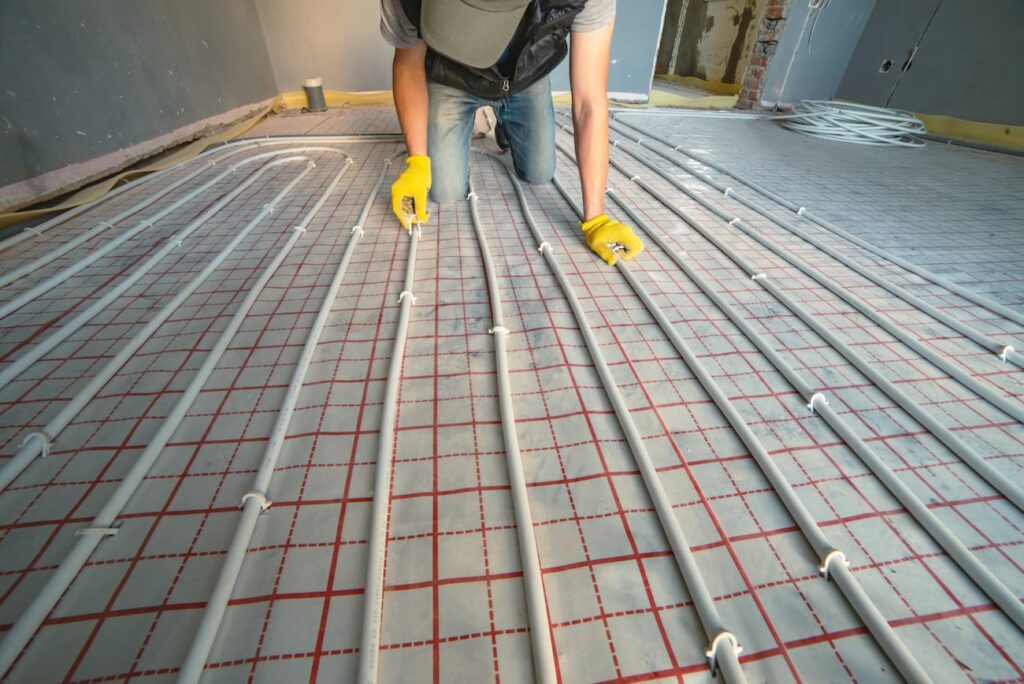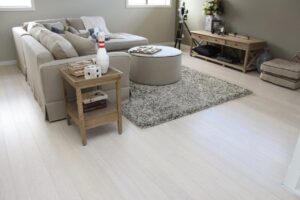Prior to check out the best flooring for radiant heating system, it is crucially to know what actually radiant heat system is.
If you have been familiar with flooring, you must have been common with the term, however, if you are just a newbie, then should stay with us to understand it first.
In this article, we are going to share not only best flooring type for radiant heating system but also other related information including the definition of radiant heating system, types of radiant heating system for the floorings, flooring types which are not required to use radiant heating system, the impact of material on heat output and the floor installation types dealing with the radiant heating system.
Now let’s have a quick read but in detail about the best flooring for radiant heating system and all related information in the following review sections.
The Definition of Radiant heating System
Radiant heating system deals with the way the heat is supplied directly to the floor.
This system works based on how large the radiant heat transfer, meaning that the heat is delivered from the hot surface to the people and objects in spaces through the radiation of infrared.
In the world of flooring, radiant heating system for flooring is installed in the floor.
The addition of radiant heating system in the flooring is aimed to provide warmth so that everyone feel comfortable in the spaces especially in the cold locations such as bathrooms, bedrooms and even kitchens.
Read Also: Inexpensive Bathroom Flooring Options To Take into The List
Types of Radiant Heating System for Flooring
There are 3 types of radiant heating system dealing with the flooring. Those are the air-heated radiant floors, electric radiant floors and hydronic radiant floors.
The air-heated radiant floors are seldom used in the flooring installation since it is not cost-effective in residential flooring while the electric radiant floors can be cost-effective as long as they include a significant thermal mass such as a thick concrete floor.
Electric radiant floors are usually in form of cables which are built into the floors.
Hydronic radiant floors, which is the third type of radiant heating system, are the most popular and the most cost-effective type especially in the climates dominated by the heat.
In short, radiant heating system is created to provide your feet with a comfortable feel in cool climates.
Radiant heating system is good especially for bathrooms, bedrooms and even kitchens in the wet season or winter.
The Best Flooring For Radiant Heating System
There are some best flooring for radiant heating system reviewed on this article. They are ceramic tile, porcelain tile, natural stone, laminate and vinyl flooring.
In this case, the radiant heating system is usually set out around the flooring thickness and thermal conductive nature. It will determine whether or not a flooring is prone to heat and water damage.
In this case, the floorings with the thicker coverings like hardwood and engineered wood can easily get damaged due to the heat and moisture penetration.
By comparison, ceramic tile porcelain and natural stone are considered the best flooring type for radiant heating system. And carpet is the worst flooring of all.
Now let’s take a quick read on the best flooring for radiant heating system in the following review sections.
Porcelain and Ceramic Tile
Porcelain and ceramic tile are considered ideal for radiant flooring heating system.
It is due to the fact that these floors are thin along with the mineral-based nature content that conducts heat properly.
Moreover, tile does not include organic products in the construction. Thus, if the hydronic system outflow the water, the tile will not degrade.
In this case, the tile quickly heats up once the system turns on.
Natural Stone Flooring
Natural stone flooring has the same radiant heating system with the porcelain and tile.
Stone is not only safe to use over the heating but also keeps the heat longer than the tile when the system shut-off.
Due to the fact that natural stone is thicker than porcelain and tile, it heats up rather slower than the tile.
However, it can keep the heat longer and will never expand. As a result, degradation does not occur.
Laminate Flooring
Truly, laminate flooring is popular with its thinness which can be the good asset in installing radiant heating system.
However, you must be aware of the precaution in order to protect the flooring.
In hydronic radiant heating system, make sure the space is free from moisture. Otherwise, the laminate floors will easily get damaged.
Further, make sure the temperature is just below the maximum point recommended by the manufacturers of laminate flooring.
In this regards, the recommended temperature must not overdo 85 degrees F.
As one of the best flooring for radiant heating system, laminate flooring will provide you with the warm underfoot of a flooring.
In this case, the radiant heating system is combined with the foam underlayment to create such comfortable feeling especially in a cold rooms.
Sheet or Tile Vinyl Flooring
In purpose of providing a comfort underfoot, radiant heating system is also good to install under the resilient floorings like sheet vinyl, vinyl tile and luxury vinyl planks.
In this case, the maximum temperature must be checked well based on the instruction of manufacturer’s installation. Typically, the temperature ranges from 70F to more than 85F.
Engineered Wood Flooring
Engineered wood flooring is listed as the one of the recommended candidate for radiant heating system.
This is due to the high-quality plywood used as a base for the top layer of the hardwood veneer.
Goodness, the plywood has a stable dimension, allowing it not to respond the temperature spikes and drops quickly.
Unluckily, due to the poor thermal conduction of wood, the heat will not transmitted quickly.
Carpeting
The use of radiant heating system in installing the carpet will reduce the efficiency. Thus, a higher temperature is required.
The addition of radiant heating system in carpeting can be a redundancy because carpet can reach R-values highly at 2.46 for plush wool.
Along with the use of polyurethane padding in which the R-value is 2.09, carpet is already warm enough without the radiant heating system.
Solid Hardwood Flooring
Radiant heating system is also possible to install under solid hardwood flooring as long as the quarter sawn wood flooring is used instead of the plain-sawn wood flooring.
In this case, the heating element must be expanded within a sleeper system subfloor, under the traditional subfloor.
It is also possible to install radiant hardwood flooring embedded within the concrete.
The use of radiant heating system will be better for the floorboards than for the wide plank due to the multiple seams to provide the floors with the flexibility.
However, the hardwood with 1.375 or more on the Janka hardness scale is not recommended to fit the radiant heating system.
Floorings That Are Not Required To Have Radiant Heating System
Now that you have already known the best flooring for radiant heating system, you need to know the floors that are not required to have radiant heating system, too.
This means that there are some flooring types at which using the radiant heat system is not a must.
Rubber Flooring
It is strongly recommended that you not use the radiant heating system on rubber flooring.
It is because there will be unpleasant odors released, making you feel uncomfortable to be in the space.
Glued-down Carpeting
In fact, the use of radiant heating system in glued-down carpeting will cause the adhesive dry and loose.
Truly, any flooring type with glued-down is a poor option for radiant heating system. Even the tongue-and-groove or fold-and-lock seaming floorings are better.
Concrete Flooring
Concrete alone is already a poor option for radiant heating system. If you insist on using it, using layer is required to hide the tubing under the top layer.
Different Floors’ Heat Up Times
Dealing with the best flooring for radiant heating system, the flooring material you choose affects the heat up time.
Basically, the thermal mass and conductivity of each flooring is different one to another.
If the thermal and conductivity is low, the heat transferred from the heating pipe or wire onto the floors surface will be quicker.
This also means that the thermal mass will also cool down more quickly than the materials with the high thermal mass.
In this case, promoting the heat transmission to the floor finish can be done by the improved system using insulation boards.
The Impact of Material On Heat Output
Truly, the flooring option you pick up will affect the maximum heat output of the system because some particular flooring finishes come with the top temperature restriction. This lead to a limitation over the heat output.
The heat output is a system which is dependent on the heated area of the floor, air and temperature.
The existence of heat output is affected by the changes of three factors (floor, air, temperature).
In this case, if the temperature is already set well, it will be easy to change the floor finish.
Thus, make sure that the heat output of the floor is greater than the heat loss.
Simply to understand, the different floor temperature will lead to a different heat output.
Hence, if you choose a flooring heated to 80.6F, you will not get your desired heat output unless you change the floor finishes heated to 84F.
Therefore, consider adding additional heating to make sure that your heating system fulfils your expectation.
Simply to understand, the maximum heat output is slightly linked to the temperature of the floor.
Based on the graph about the relation of heat output and floor temperature, the underfloor heating system will fit 12C of temperature.
Floor Installation Types Related with Radiant Heating System
No matter you use tubing or cables, the installation types of electric and hydronic radiant system are just similar.
In this case, the wet installations using the embedded tubing or cables are commonly found in solid hardwood floor.
The tubing and cables are also used on the thick concrete flooring or in a thin layer of concrete.
This way, concrete slabs are considered as the ideal options for heat storage derived from the solar energy systems.
The downside of the thick slabs lies only on the slow thermal response time.
Thus, it is recommended to maintain a constant temperature at homes with these kinds of radiant heating systems.
In dry installations, the tubing or cables are suspended under the subfloor between the joists.
This way, you need to drill through the floor joists in order to install the tubing. Install the reflective insulation under the tubes to promote the heat upward.
In this case, you can also install the tubing or cables from the above part of the floor between the two subfloor’s layers.
Read Also: Best Pet-Friendly Floor To Consider Installing
Floor Coverings for Radiant Heating System
It is best described that floor coverings are the most effective for radiant heating system especially on ceramic tile.
This way, the ceramic tile can conduct the heat well and keep the thermal in the storage.
The usual floor coverings such as vinyl and linoleum sheets, carpeting and wood are also good to use along with the radiant heating system.
However, the floors with room insulation will experience efficiency reduction.
If you want to use carpet along with the addition of radiant heating system, it is suggested that you choose the thin carpet with the dense padding.
If you have a room and you want to use floor coverings, the room must have a separate tubing loop in order that the heating system will work properly.
If you choose wood flooring, it should be the laminate wood flooring type. Don’t use solid hardwood.
Using the laminate wood flooring is aimed to reduce the chance of wood shrinking and cracking because of the drying effect of the heat.
So what is the relation between the floor coverings and radiant heating system?
You might already have had an existing floor yet you want to use floor coverings such as carpet.
So you can also install the radiant heating system to support the way you are creating a warm and comfortable flooring at your home.
Finally you will have the best flooring for radiant heating system.





